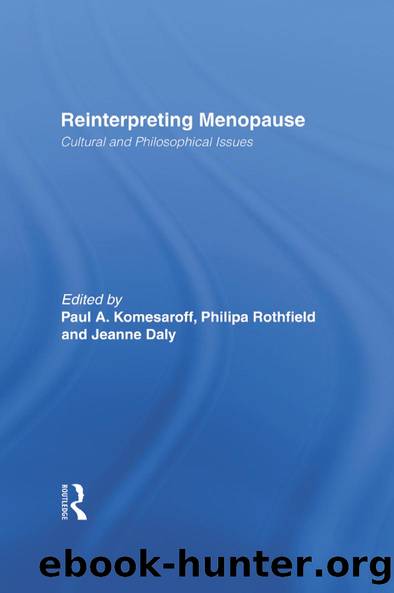Reinterpreting Menopause by Paul Komesaroff Philipa Rothfield Jeanne Daly

Author:Paul Komesaroff, Philipa Rothfield, Jeanne Daly [Paul Komesaroff, Philipa Rothfield, Jeanne Daly]
Language: eng
Format: epub
Tags: Nonfiction, Social & Cultural Studies, Social Science, Gender Studies, Feminism & Feminist Theory, Women's Studies, Sociology
ISBN: 9781136049026
Publisher: Taylor and Francis
Published: 2013-05-13T04:00:00+00:00
Difficult Texts and Clear Pictures
If one accepts that human thinking is always analogistic, synthetic, and ratiocinative, then it is hardly surprising that the dark places of the human psyche, the âprimitiveâ past of human history, and the so-called savage places of the earth should become confused or mutually informing. Practices generate metaphors, and the metaphors âengenderâ other practices. Age-old oppositions of light and dark, of good and evil, became implicated in ideas of reason and unreason, purity and impurity, evolution and devolution. The development of increasingly sophisticated technologies of microscopy, magnification, radiography in conjuncton with photography meant that the âdark placesâ of bodies were poetically, as well as literally, opened to the light of reason. Michel Foucault argues in The Order of Things that a âvitalizedâ science of the body did not exist before the nineteenth century, that eighteenth-century discourses of the body primarily presented mechanized models and static categories. There is an Enlightenment preoccupation with genera, phyla, and taxonomical definitions rather than with fluid and vital articulations. The invention of the X-ray not only allowed a literal image of inner recesses but also brought with it more complicating ânegativeâ associations, with Doppelgängern and older figures of inversion given new rhetorical investments. The âvitalityâ and various incandescences of Percy Bysshe Shelley's poetry, for instance, had more than a little to do with his fascination with the new technology of electricityâwith his passion for âgalvanizingâ himself with a homemade apparatus, and his interest in the possibility of ârevivifyingâ inanimate bodies. One need not wait upon the heirophant of discourse theory for an awareness of such epistemological shifts. It is almost a disciplinary cliché for historians of science to think of a âgalvanizationâ of the static body of the âElizabethan world picture.â As some critics of the cleanness of Foucault's âepistemological breaksâ have argued, the edges are more messyâboth between âerasâ and in the writings of particular writers.32
Whatever the quibbles about periodization, it seems entirely valid to conjure a period of time in which technical developments in the biological sciences determined a new âfluidityâ and âvitality.â Metaphors of cathexis (expression and repression) abounded, and studies of the permeability of tissues and of circulatory mechanisms enriched a tropology of infiltration and dissemination, as well as provided new resonances in an existent poetics of illumination and penetration. Electrical models were giving way to even more dynamic and complex visions of âinvisibleâ secretions, and such models were subtly imbricated with images of racial and genetic contamination. For instance, in an early essay on the psychical mechanism of hysteria (1892), Freud suggested that âthe psychical traumaâor more precisely the memory of the traumaâacts like a foreign body which long after its entry must continue to be regarded as an agent that is still at work.â33 Some recent commentaries emphasize this point as âthe birthplaceâ of psychoanalysis. Here Freud wrests his thinking away from his teacher Charcot and from a model of electrical excitation then dominant in mental pathology. His inseminating âalienâ metaphor (common in an age
Download
This site does not store any files on its server. We only index and link to content provided by other sites. Please contact the content providers to delete copyright contents if any and email us, we'll remove relevant links or contents immediately.
On the Front Line with the Women Who Fight Back by Stacey Dooley(4800)
The Rules Do Not Apply by Ariel Levy(4795)
The Lonely City by Olivia Laing(4714)
Bluets by Maggie Nelson(4437)
The Confidence Code by Katty Kay(4166)
Three Women by Lisa Taddeo(3329)
Not a Diet Book by James Smith(3302)
Inferior by Angela Saini(3213)
Confessions of a Video Vixen by Karrine Steffans(3212)
A Woman Makes a Plan by Maye Musk(3179)
Pledged by Alexandra Robbins(3106)
Wild Words from Wild Women by Stephens Autumn(3047)
Nice Girls Don't Get the Corner Office by Lois P. Frankel(2975)
Brave by Rose McGowan(2766)
Women & Power by Mary Beard(2693)
Why I Am Not a Feminist by Jessa Crispin(2670)
The Girl in the Spider's Web: A Lisbeth Salander novel, continuing Stieg Larsson's Millennium Series by Lagercrantz David(2649)
The Clitoral Truth: The Secret World at Your Fingertips by Rebecca Chalker(2635)
Women on Top by Nancy Friday(2494)
